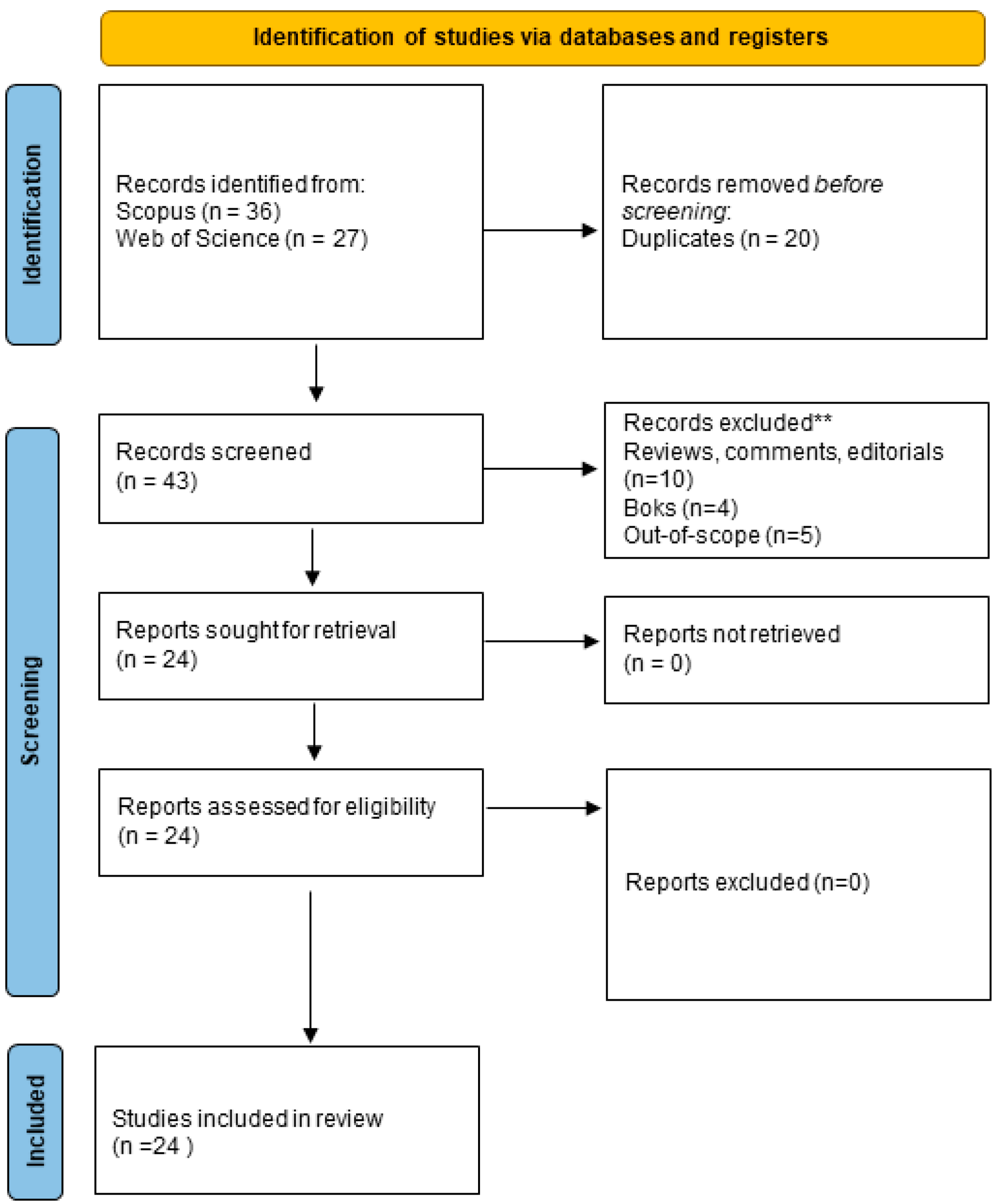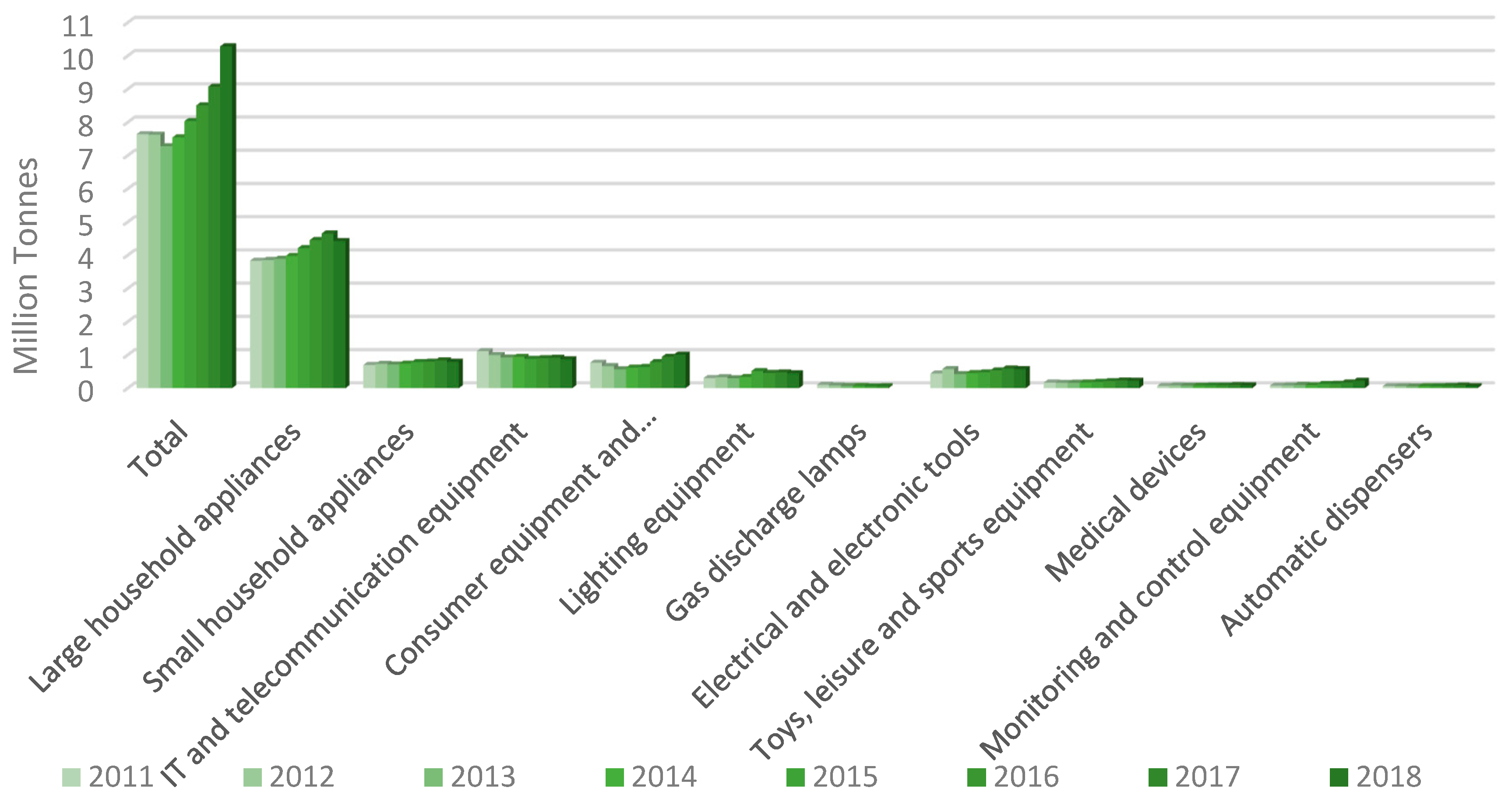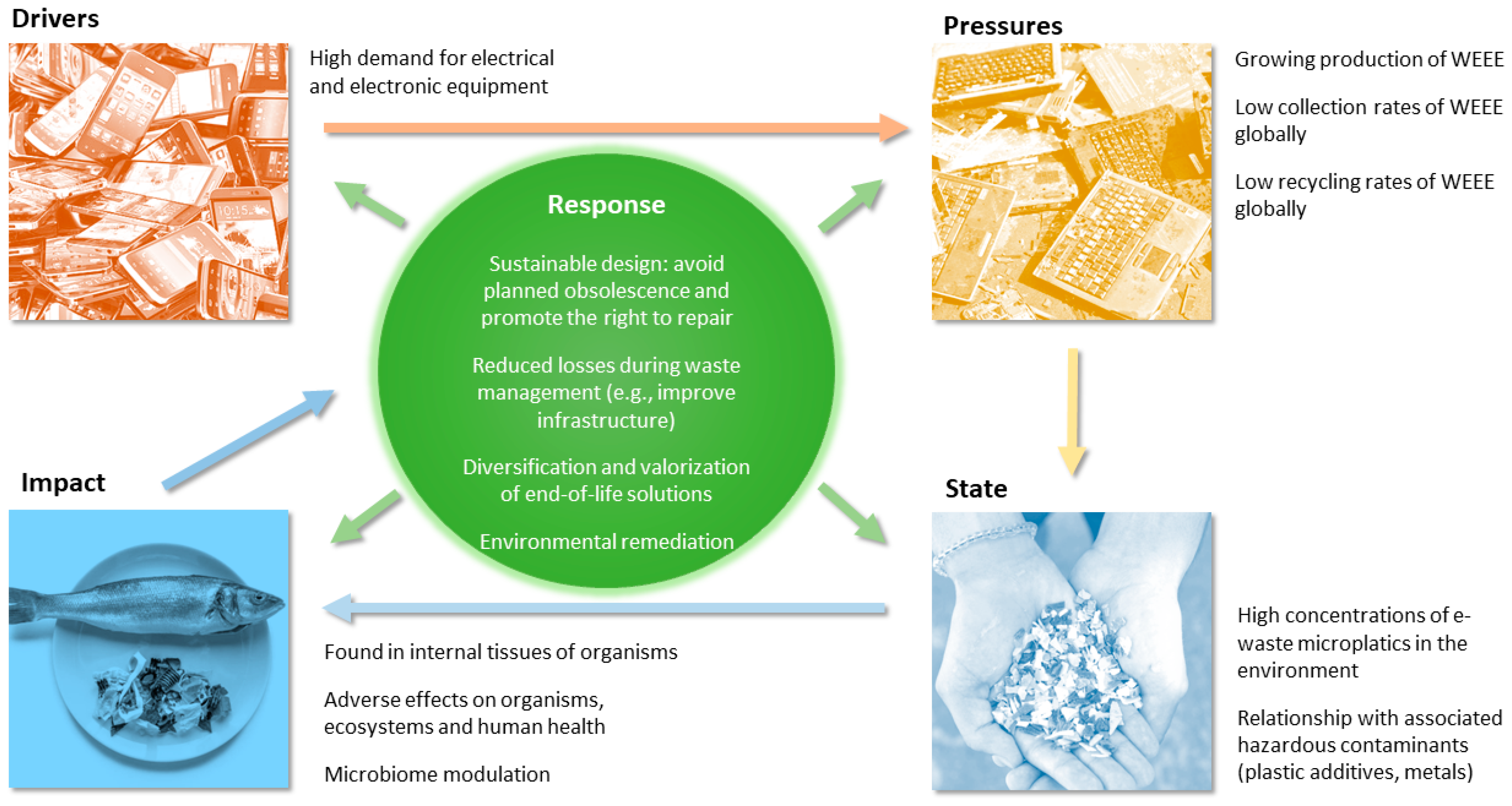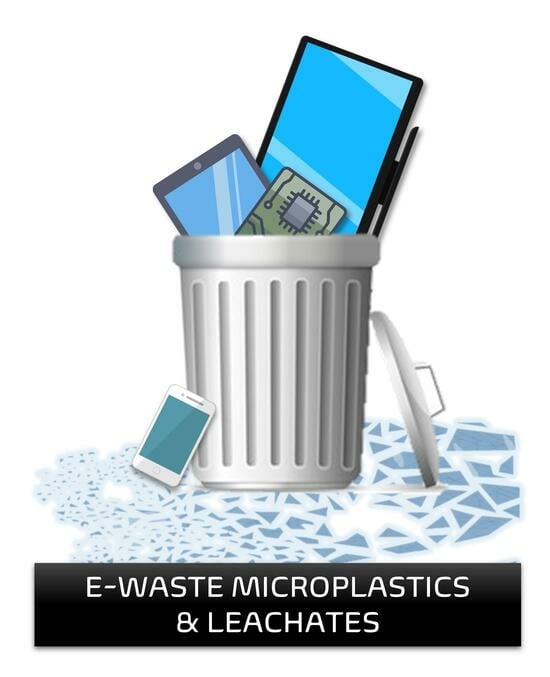The Environmental Impact of E-Waste Microplastics: A Systematic Review and Analysis Based on the Driver–Pressure–State–Impact–Response (DPSIR) Framework
Abstract
:1. Introduction
2. Materials and Methods
3. Results and Discussion
3.1. Drivers and Pressures: Trends in Electronics Consumption and E-Waste Production in the European Union
3.2. State: Concentrations of E-Waste Microplastics in the Environment
| Sample | Location | Concentration | Type | Reference | |||
|---|---|---|---|---|---|---|---|
| Region | Facility | Mean | Maximum | Polymers | Shapes | ||
| Soil | Guiyu, China | E-waste disassembling site (abandoned) | 9450 particles kg−1 | 34,100 particles kg−1 | PS (12.44%), PP (11.98%), PVA (10.51%), polyphenylene sulfide (7.74%), PE (5.35%) | granules (96.42%), <1 mm (88.61%), black (33.17%), white (33.17%) | Chai et al., 2020a; Chai et al., 2020b; Chai et al., 2021 [43,44,45] |
| Longtang County, China | E-waste recycling site | 2250 particles kg−1 (12.2 mg g−1), | 14,200 particles kg−1 (153 mg g−1) | ABS | blue, black, red | Zhang et al., 2021 [46] | |
| Shanghai, China | E-waste disassembling site | 24,888 particles kg−1 | 130,680 particles kg−1 | PMMA, other 102 kinds | white, black | Zhan et al., 2022 [47] | |
| India | E-waste dumping sites | 1411 particles kg−1 | 13,245 particles kg−1 | PET, PVC | na | Tun et al., 2022 [38] | |
| Dust | China | Roads inside an e-waste disassembling site | na | 7778 particles 5 g−1 | tire rubber, PS, PP, PMMA | na | Zhang et al., 2022 [37] |
| Shanghai, China | E-waste disassembling site | 44,277 particles 50 g−1 | 261,970 particles 50 g−1 | na | na | Zhan et al., 2022 [47] | |
| Air | Shanghai, China | E-waste disassembling site | 530 particles 100 m−3 | 1102 particles 100 m−3 | na | na | Zhan et al., 2022 [47] |
3.3. State: Additives and Leachates from E-Waste Microplastics
3.4. Impacts: Adverse Effects of E-Waste Microplastics and Leachates on the Environment and Ecosystems
3.5. Impacts: Adverse Effects of E-Waste Microplastics on Human Health
3.6. Response: Prevention and Mitigation of E-Waste Microplastics
3.7. Drivers–Pressures–State–Impacts–Responses (DPSIR) Framework
3.8. Knowledge Gaps in E-Waste Microplastics
4. Conclusions
Supplementary Materials
Author Contributions
Funding
Data Availability Statement
Conflicts of Interest
References
- Shittu, O.S.; Williams, I.D.; Shaw, P.J. Global E-Waste Management: Can WEEE Make a Difference? A Review of e-Waste Trends, Legislation, Contemporary Issues and Future Challenges. Waste Manag. 2021, 120, 549–563. [Google Scholar] [CrossRef]
- Rautela, R.; Arya, S.; Vishwakarma, S.; Lee, J.; Kim, K.-H.; Kumar, S. E-Waste Management and Its Effects on the Environment and Human Health. Sci. Total Environ. 2021, 773, 145623. [Google Scholar] [CrossRef]
- Turner, A. Black Plastics: Linear and Circular Economies, Hazardous Additives and Marine Pollution. Environ. Int. 2018, 117, 308–318. [Google Scholar] [CrossRef]
- Shaw, E.J.; Turner, A. Recycled Electronic Plastic and Marine Litter. Sci. Total Environ. 2019, 694, 133644. [Google Scholar] [CrossRef] [PubMed]
- Althaf, S.; Babbitt, C.W.; Chen, R. The Evolution of Consumer Electronic Waste in the United States. J. Ind. Ecol. 2021, 25, 693–706. [Google Scholar] [CrossRef]
- Kuang, H.; Li, Y.; Li, L.; Ma, S.; An, T.; Fan, R. Four-Year Population Exposure Study: Implications for the Effectiveness of e-Waste Control and Biomarkers of e-Waste Pollution. Sci. Total Environ. 2022, 842, 156595. [Google Scholar] [CrossRef] [PubMed]
- Osman, A.I.; Hosny, M.; Eltaweil, A.S.; Omar, S.; Elgarahy, A.M.; Farghali, M.; Yap, P.-S.; Wu, Y.-S.; Nagandran, S.; Batumalaie, K.; et al. Microplastic Sources, Formation, Toxicity and Remediation: A Review. Environ. Chem. Lett. 2023, 21, 2129–2169. [Google Scholar] [CrossRef] [PubMed]
- Kyriakopoulos, G.L.; Zamparas, M.G.; Kapsalis, V.C. Investigating the Human Impacts and the Environmental Consequences of Microplastics Disposal into Water Resources. Sustainability 2022, 14, 828. [Google Scholar] [CrossRef]
- Wirtu, Y.D.; Tucho, G.T. E-Waste: Growing Environmental and Health Problems and Its Management Alternatives in Developing Countries. Environ. Rev. 2022, 30, 524–536. [Google Scholar] [CrossRef]
- Singh, N.; Duan, H.; Tang, Y. Toxicity Evaluation of E-Waste Plastics and Potential Repercussions for Human Health. Environ. Int. 2020, 137, 105559. [Google Scholar] [CrossRef]
- Jain, M.; Kumar, D.; Chaudhary, J.; Kumar, S.; Sharma, S.; Singh Verma, A. Review on E-Waste Management and Its Impact on the Environment and Society. Waste Manag. Bull. 2023, 1, 34–44. [Google Scholar] [CrossRef]
- OECD. OECD Environmental Indicators. Available online: https://www.oecd.org/environment/indicators-modelling-outlooks/24993546.pdf (accessed on 24 November 2023).
- European Environment Agency Halting the Loss of Biodiversity by 2010: Proposal for a First Set of Indicators to Monitor Progress in Europe. Available online: https://www.eea.europa.eu/publications/technical_report_2007_11 (accessed on 24 November 2023).
- Bakhiyi, B.; Gravel, S.; Ceballos, D.; Flynn, M.A.; Zayed, J. Has the Question of E-Waste Opened a Pandora’s Box? An Overview of Unpredictable Issues and Challenges. Environ. Int. 2018, 110, 173–192. [Google Scholar] [CrossRef]
- Directive 2011/65/EU of the European Parliament and of the Council of 8 June 2011 on the Restriction of the Use of Certain Hazardous Substances in Electrical and Electronic Equipment (Recast) Text with EEA Relevance. Available online: https://eur-lex.europa.eu/legal-content/EN/TXT/?uri=CELEX:32011L0065 (accessed on 24 November 2023).
- Egbuna, C.; Amadi, C.N.; Patrick-Iwuanyanwu, K.C.; Ezzat, S.M.; Awuchi, C.G.; Ugonwa, P.O.; Orisakwe, O.E. Emerging Pollutants in Nigeria: A Systematic Review. Environ. Toxicol. Pharmacol. 2021, 85, 103638. [Google Scholar] [CrossRef] [PubMed]
- Ouda, M.; Kadadou, D.; Swaidan, B.; Al-Othman, A.; Al-Asheh, S.; Banat, F.; Hasan, S.W. Emerging Contaminants in the Water Bodies of the Middle East and North Africa (MENA): A Critical Review. Sci. Total Environ. 2021, 754, 142177. [Google Scholar] [CrossRef]
- Yalwaji, B.; John-Nwagwu, H.O.; Sogbanmu, T.O. Plastic Pollution in the Environment in Nigeria: A Rapid Systematic Review of the Sources, Distribution, Research Gaps and Policy Needs. Sci. Afr. 2022, 16, e01220. [Google Scholar] [CrossRef]
- Wang, R.; Cheng, H.; Gong, Y.; Huang, T. New Brominated Flame Retardant Decabromodiphenyl Ethane (DBDPE) in Water Sediments: A Review of Contamination Characteristics, Exposure Pathways, Ecotoxicological Effects and Health Risks. Environ. Pollut. 2023, 334, 122121. [Google Scholar] [CrossRef]
- Vasiljevic, T.; Harner, T. Bisphenol A and Its Analogues in Outdoor and Indoor Air: Properties, Sources and Global Levels. Sci. Total Environ. 2021, 789, 148013. [Google Scholar] [CrossRef] [PubMed]
- Prata, J.C.; Patrício Silva, A.L.; da Costa, J.P.; Mouneyrac, C.; Walker, T.R.; Duarte, A.C.; Rocha-Santos, T. Solutions and Integrated Strategies for the Control and Mitigation of Plastic and Microplastic Pollution. Int. J. Environ. Res. Public Health 2019, 16, 2411. [Google Scholar] [CrossRef]
- The Lancet Planetary Health Microplastics and Human Health—An Urgent Problem. Lancet Planet. Health 2017, 1, e254. [CrossRef]
- Sripada, K.; Wierzbicka, A.; Abass, K.; Grimalt, J.O.; Erbe, A.; Röllin, H.B.; Weihe, P.; Díaz, G.J.; Singh, R.R.; Visnes, T.; et al. A Children’s Health Perspective on Nano- and Microplastics. Environ. Health Perspect. 2022, 130, 015001. [Google Scholar] [CrossRef]
- Amaneesh, C.; Anna Balan, S.; Silpa, P.S.; Kim, J.W.; Greeshma, K.; Aswathi Mohan, A.; Robert Antony, A.; Grossart, H.-P.; Kim, H.-S.; Ramanan, R. Gross Negligence: Impacts of Microplastics and Plastic Leachates on Phytoplankton Community and Ecosystem Dynamics. Environ. Sci. Technol. 2023, 57, 5–24. [Google Scholar] [CrossRef]
- Impellitteri, F.; Curpăn, A.-S.; Plăvan, G.; Ciobica, A.; Faggio, C. Hemocytes: A Useful Tool for Assessing the Toxicity of Microplastics, Heavy Metals, and Pesticides on Aquatic Invertebrates. Int. J. Environ. Res. Public Health 2022, 19, 16830. [Google Scholar] [CrossRef]
- Zhang, Q.; Wang, R.; Shen, Y.; Zhan, L.; Xu, Z. An Ignored Potential Microplastic Contamination of a Typical Waste Glass Recycling Base. J. Hazard. Mater. 2022, 422, 126854. [Google Scholar] [CrossRef]
- Al-Salem, S.M.; Uddin, S.; Lyons, B. Evidence of Microplastics (MP) in Gut Content of Major Consumed Marine Fish Species in the State of Kuwait (of the Arabian/Persian Gulf). Mar. Pollut. Bull. 2020, 154, 111052. [Google Scholar] [CrossRef] [PubMed]
- Luo, T.; Dai, X.; Wei, W.; Xu, Q.; Ni, B.-J. Microplastics Enhance the Prevalence of Antibiotic Resistance Genes in Anaerobic Sludge Digestion by Enriching Antibiotic-Resistant Bacteria in Surface Biofilm and Facilitating the Vertical and Horizontal Gene Transfer. Environ. Sci. Technol. 2023, 57, 14611–14621. [Google Scholar] [CrossRef]
- Landrigan, P.J.; Raps, H.; Cropper, M.; Bald, C.; Brunner, M.; Canonizado, E.M.; Charles, D.; Chiles, T.C.; Donohue, M.J.; Enck, J.; et al. The Minderoo-Monaco Commission on Plastics and Human Health. Ann. Glob. Health 2023, 89, 23. [Google Scholar] [CrossRef]
- Rodríguez-Hernández, A.G.; Chiodoni, A.; Bocchini, S.; Vazquez-Duhalt, R. 3D Printer Waste, a New Source of Nanoplastic Pollutants. Environ. Pollut. 2020, 267, 115609. [Google Scholar] [CrossRef]
- PlasticsEurope Plastics-the Facts. 2019. Available online: https://www.plasticseurope.org/en/resources/market-data (accessed on 8 April 2023).
- Eurostat Waste Electrical and Electronic Equipment (WEEE) by Waste Management Operations (ENV_WASELEE). Available online: https://ec.europa.eu/eurostat/databrowser/view/ENV_WASELEE__custom_3139259/default/table?lang=en (accessed on 8 April 2023).
- Europe, I. Collection and Recycling of WEEE: Key Learnings. Available online: https://www.interregeurope.eu/find-policy-solutions/webinar/collection-and-recycling-of-weee-key-learnings#:~:text=To20%improve20%reuse20%and20%recycling,he20%Circular20%Economy20%Action20%Plan (accessed on 9 August 2023).
- Liu, X.; Lu, X.; Feng, Y.; Zhang, L.; Yuan, Z. Recycled WEEE Plastics in China: Generation Trend and Environmental Impacts. Resour. Conserv. Recycl. 2022, 177, 105978. [Google Scholar] [CrossRef]
- Jacques, O.; Prosser, R.S. A Probabilistic Risk Assessment of Microplastics in Soil Ecosystems. Sci. Total Environ. 2021, 757, 143987. [Google Scholar] [CrossRef] [PubMed]
- Li, Y.; Lin, M.; Ni, Z.; Yuan, Z.; Liu, W.; Ruan, J.; Tang, Y.; Qiu, R. Ecological Influences of the Migration of Micro Resin Particles from Crushed Waste Printed Circuit Boards on the Dumping Soil. J. Hazard. Mater. 2020, 386, 121020. [Google Scholar] [CrossRef]
- Zhang, Q.; Wang, R.; Shen, Y.; Zhan, L.; Xu, Z. Characteristics of Unorganized Emissions of Microplastics from Road Fugitive Dust in Urban Mining Bases. Sci. Total Environ. 2022, 827, 154355. [Google Scholar] [CrossRef]
- Tun, T.Z.; Kunisue, T.; Tanabe, S.; Prudente, M.; Subramanian, A.; Sudaryanto, A.; Viet, P.H.; Nakata, H. Microplastics in Dumping Site Soils from Six Asian Countries as a Source of Plastic Additives. Sci. Total Environ. 2022, 806, 150912. [Google Scholar] [CrossRef]
- Camargo, A.L.G.; Girard, P.; Sanz-Lazaro, C.; Silva, A.C.M.; de Faria, É.; Figueiredo, B.R.S.; Caixeta, D.S.; Blettler, M.C.M. Microplastics in Sediments of the Pantanal Wetlands, Brazil. Front. Environ. Sci. 2022, 10, 1017480. [Google Scholar] [CrossRef]
- Turner, A.; Williams, T.; Pitchford, T. Transport, Weathering and Pollution of Plastic from Container Losses at Sea: Observations from a Spillage of Inkjet Cartridges in the North Atlantic Ocean. Environ. Pollut. 2021, 284, 117131. [Google Scholar] [CrossRef]
- Turner, A.; Wallerstein, C.; Arnold, R. Identification, Origin and Characteristics of Bio-Bead Microplastics from Beaches in Western Europe. Sci. Total Environ. 2019, 664, 938–947. [Google Scholar] [CrossRef]
- Gong, W.; Guo, Y.; Yang, W.; Wu, Z.; Xing, R.; Liu, J.; Wei, W.; Zhou, J.; Guo, Y.; Li, K.; et al. Scalable and Reconfigurable Green Electronic Textiles with Personalized Comfort Management. ACS Nano 2022, 16, 12635–12644. [Google Scholar] [CrossRef]
- Chai, B.-W.; Yin, H.; Wei, Q.; Lu, G.-N.; Dang, Z. Relationships Between Microplastic and Surrounding Soil in an E-Waste Zone of China. Huanjing Kexue Environ. Sci. 2021, 42, 1073–1080. [Google Scholar] [CrossRef]
- Chai, B.; Li, X.; Liu, H.; Lu, G.; Dang, Z.; Yin, H. Bacterial Communities on Soil Microplastic at Guiyu, an E-Waste Dismantling Zone of China. Ecotoxicol. Environ. Saf. 2020, 195, 110521. [Google Scholar] [CrossRef] [PubMed]
- Chai, B.; Wei, Q.; She, Y.; Lu, G.; Dang, Z.; Yin, H. Soil Microplastic Pollution in an E-Waste Dismantling Zone of China. Waste Manag. 2020, 118, 291–301. [Google Scholar] [CrossRef] [PubMed]
- Zhang, J.; Wu, X.; Guo, H.; Zheng, X.; Mai, B. Pollution of Plastic Debris and Halogenated Flame Retardants (HFRs) in Soil from an Abandoned e-Waste Recycling Site: Do Plastics Contribute to (HFRs) in Soil? J. Hazard. Mater. 2021, 410, 124649. [Google Scholar] [CrossRef] [PubMed]
- Zhan, L.; Zhang, Q.; Bulati, A.; Wang, R.; Xu, Z. Characteristics of Microplastics and the Role for Complex Pollution in E-Waste Recycling Base of Shanghai, China. Environ. Int. 2022, 169, 107515. [Google Scholar] [CrossRef]
- Lu, R.; Zhang, Y.; Guo, K.; He, Z.; Yu, W.; Cao, X.; Zheng, X.; Mai, B. Organophosphate Flame Retardants and Plastics in Soil from an Abandoned E-Waste Recycling Site: Significant Ecological Risks Derived from Plastic Debris. Environ. Sci. Pollut. Res. 2023, 30, 58933–58943. [Google Scholar] [CrossRef] [PubMed]
- Goswami, P.; Ohura, T.; Subasinghe, S.; Wickrama-Arachchige, A.U.-K.; Takeuchi, S.; Imaki, M.; Niizuma, Y.; Watanabe, M.; Guruge, K.S. Voyaging of Halogenated Polycyclic Aromatic Hydrocarbons, an Emerging Group of Pollutants, on Micro-Mesoplastics in the Marine Environment. J. Hazard. Mater. 2023, 460, 132502. [Google Scholar] [CrossRef] [PubMed]
- Turner, A.; Scott, J.W.; Green, L.A. Rare Earth Elements in Plastics. Sci. Total Environ. 2021, 774, 145405. [Google Scholar] [CrossRef] [PubMed]
- Chakraborty, P.; Sampath, S.; Mukhopadhyay, M.; Selvaraj, S.; Bharat, G.K.; Nizzetto, L. Baseline Investigation on Plasticizers, Bisphenol A, Polycyclic Aromatic Hydrocarbons and Heavy Metals in the Surface Soil of the Informal Electronic Waste Recycling Workshops and Nearby Open Dumpsites in Indian Metropolitan Cities. Environ. Pollut. 2019, 248, 1036–1045. [Google Scholar] [CrossRef] [PubMed]
- Mukhopadhyay, M.; Sampath, S.; Muñoz-Arnanz, J.; Jiménez, B.; Chakraborty, P. Plasticizers and Bisphenol A in Adyar and Cooum Riverine Sediments, India: Occurrences, Sources and Risk Assessment. Environ. Geochem. Health 2020, 42, 2789–2802. [Google Scholar] [CrossRef] [PubMed]
- Zhu, Y.; Li, X.; Wang, L.; Hui, N.; Ma, J.; Chen, F. Adsorption of BDE-209 to Polyethylene Microplastics: Effect of Microplastics Property and Metal Ions. Water Air Soil Pollut. 2021, 232, 494. [Google Scholar] [CrossRef]
- Runde, K.; Castro, G.; Vike-Jonas, K.; González, S.V.; Asimakopoulos, A.G.; Arp, H.P.H. Occurrence and Sorption Behaviour of Bisphenols and Benzophenone UV-Filters in e-Waste Plastic and Vehicle Fluff. J. Hazard. Mater. 2022, 426, 127814. [Google Scholar] [CrossRef]
- Pomata, D.; Di Filippo, P.; Riccardi, C.; Buiarelli, F.; Marini, F.; Romani, L.; Lucarelli, F.; Pazzi, G.; Galarini, R.; Simonetti, G. Concentrations and Co-Occurrence of 101 Emerging and Legacy Organic Pollutants in the Ultrafine, Fine and Coarse Fractions of Airborne Particulates Associated with Treatment of Waste from Electrical and Electronic Equipment. Chemosphere 2023, 338, 139443. [Google Scholar] [CrossRef]
- Zheng, X.; Wu, X.; Zheng, Q.; Mai, B.-X.; Qiu, R. Transfer of Microplastics in Terrestrial and Aquatic Food Webs: The Impact of E-Waste Debris and Ecological Traits. Environ. Sci. Technol. 2022, 57, 1300–1308. [Google Scholar] [CrossRef]
- Zhang, W.; Li, T.; Li, Y.; Ma, Y.; Xie, H.Q.; Zou, X.; Wu, J.; Li, Y.; Wang, R.; Zhao, B. Gut Microbiota of Anabas Testudineus (Bloch, 1792) in the e-Waste Dismantling Region: In Situ Status and Relationship with Internal Metal Burden. Aquat. Toxicol. 2022, 248, 106171. [Google Scholar] [CrossRef] [PubMed]
- Rummel, C.D.; Schäfer, H.; Jahnke, A.; Arp, H.P.H.; Schmitt-Jansen, M. Effects of Leachates from UV-Weathered Microplastic on the Microalgae Scenedesmus Vacuolatus. Anal. Bioanal. Chem. 2022, 414, 1469–1479. [Google Scholar] [CrossRef] [PubMed]
- Han, Y.; Fu, M.; Wu, J.; Zhou, S.; Qiao, Z.; Peng, C.; Zhang, W.; Liu, F.; Ye, C.; Yang, J. Polylactic Acid Microplastics Induce Higher Biotoxicity of Decabromodiphenyl Ethane on Earthworms (Eisenia fetida) Compared to Polyethylene and Polypropylene Microplastics. Sci. Total Environ. 2023, 862, 160909. [Google Scholar] [CrossRef] [PubMed]
- Fu, M.; Tan, J.; Zhou, S.; Liu, P.; Qiao, Z.; Han, Y.; Zhang, W.; Peng, C. Acrylonitrile Butadiene Styrene Microplastics Aggravate the Threat of Decabromodiphenyl Ethane to Eisenia Fetida: Bioaccumulation, Tissue Damage, and Transcriptional Responses. Sci. Total Environ. 2023, 889, 164303. [Google Scholar] [CrossRef]
- de Souza Machado, A.A.; Lau, C.W.; Till, J.; Kloas, W.; Lehmann, A.; Becker, R.; Rilling, M.C. Impacts of Microplastics on the Soil Biophysical Environment. Environ. Sci. Technol. 2018, 52, 9656–9665. [Google Scholar] [CrossRef]
- Wan, Y.; Wu, C.; Xue, Q.; Hui, X. Effects of Plastic Contamination on Water Evaporation and Desiccation Cracking in Soil. Sci. Total Environ. 2019, 654, 576–582. [Google Scholar] [CrossRef]
- Sharma, M.D.; Elanjickal, A.I.; Mankar, J.S.; Krupadam, R.J. Assessment of Cancer Risk of Microplastics Enriched with Polycyclic Aromatic Hydrocarbons. J. Hazard. Mate.r 2020, 398, 122994. [Google Scholar] [CrossRef]
- Shi, P.; Wan, Y.; Grandjean, A.; Lee, J.-M.; Tay, C.Y. Clarifying the In-Situ Cytotoxic Potential of Electronic Waste Plastics. Chemosphere 2021, 269, 128719. [Google Scholar] [CrossRef]
- Lee, S.; Hong, Y.; Shim, B.S. Biodegradable PEDOT:PSS/Clay Composites for Multifunctional Green-Electronic Materials. Adv. Sustain. Syst. 2022, 6, 2100056. [Google Scholar] [CrossRef]
- Proposal for a Directive on Common Rules Promoting the Repair of Goods. Available online: https://www.europarl.europa.eu/legislative-train/theme-a-european-green-deal/file-right-to-repair (accessed on 7 April 2023).
- Sahajwalla, V.; Gaikwad, V. The Present and Future of E-Waste Plastics Recycling. Curr. Opin. Green Sustain. Chem. 2018, 13, 102–107. [Google Scholar] [CrossRef]
- Wang, Z.; Jiang, H.; Zhang, Y.; Bian, K.; Wang, H.; Wang, C. Stepwise Flotation Separation of WEEE Plastics by Polymeric Aluminum Chloride towards Source Control of Microplastics. Waste Manag. 2022, 149, 1–10. [Google Scholar] [CrossRef]
- Operation Clean Sweep. Available online: https://www.opcleansweep.org/manual/prevention-containment-cleanup-procedures/spills-and-packaging/ (accessed on 7 April 2023).
- Murphy, E.L.; Bernard, M.; Iacona, G.; Borrelle, S.B.; Barnes, M.; McGivern, A.; Emmanuel, J.; Gerber, L.R. A Decision Framework for Estimating the Cost of Marine Plastic Pollution Interventions. Conserv. Biol. 2022, 36, e13827. [Google Scholar] [CrossRef]
- Yang, W.-D.; Sun, Q.; Ni, H.-G. Cost-Benefit Analysis of Metal Recovery from e-Waste: Implications for International Policy. Waste Manag. 2021, 123, 42–47. [Google Scholar] [CrossRef]
- Nikiema, J.; Asiedu, Z. A Review of the Cost and Effectiveness of Solutions to Address Plastic Pollution. Environ. Sci. Pollut. Res. 2022, 29, 24547–24573. [Google Scholar] [CrossRef] [PubMed]
- Godfrey, L. Waste Plastic, the Challenge Facing Developing Countries—Ban It, Change It, Collect It? Recycling 2019, 4, 3. [Google Scholar] [CrossRef]
- Bergez, J.-E.; Béthinger, A.; Bockstaller, C.; Cederberg, C.; Ceschia, E.; Guilpart, N.; Lange, S.; Müller, F.; Reidsma, P.; Riviere, C.; et al. Integrating Agri-Environmental Indicators, Ecosystem Services Assessment, Life Cycle Assessment and Yield Gap Analysis to Assess the Environmental Sustainability of Agriculture. Ecol. Indic. 2022, 141, 109107. [Google Scholar] [CrossRef]
- Polák, M.; Drápalová, L. Estimation of End of Life Mobile Phones Generation: The Case Study of the Czech Republic. Waste Manag. 2012, 32, 1583–1591. [Google Scholar] [CrossRef]
- Ta, A.T.; Babel, S. Microplastics and Heavy Metals in a Tropical River: Understanding Spatial and Seasonal Trends and Developing Response Strategies Using DPSIR Framework. Sci. Total Environ. 2023, 897, 165405. [Google Scholar] [CrossRef]
- Song, G.; Cao, H.; Liu, L.; Jin, M. Analysis of Marine Microplastic Pollution of Disposable Masks under COVID-19 Epidemic—A DPSIR Framework. Int. J. Environ. Res. Public Health 2022, 19, 16299. [Google Scholar] [CrossRef] [PubMed]
- Miranda, M.N.; Silva, A.M.T.; Pereira, M.F.R. Microplastics in the Environment: A DPSIR Analysis with Focus on the Responses. Sci. Total Environ. 2020, 718, 134968. [Google Scholar] [CrossRef]
- Prasittisopin, L.; Ferdous, W.; Kamchoom, V. Microplastics in Construction and Built Environment. Dev. Built Environ. 2023, 15, 100188. [Google Scholar] [CrossRef]



| Type | Drivers | Pressures | State | Impact | Responses | Reference |
|---|---|---|---|---|---|---|
| E-waste microplastics |
|
|
|
|
| Present work |
| Microplastics in rivers in Thailand |
|
|
|
|
| Ta et al., 2023 [76] |
| Microplastics from disposable masks |
|
|
|
|
| Song et al., 2022 [77] |
| Microplastics in the environment |
|
|
|
|
| Miranda et al., 2020 [78] |
| Microplastics from building and construction industries |
|
|
|
|
| Prasittisopin et al., 2023 [79] |
Disclaimer/Publisher’s Note: The statements, opinions and data contained in all publications are solely those of the individual author(s) and contributor(s) and not of MDPI and/or the editor(s). MDPI and/or the editor(s) disclaim responsibility for any injury to people or property resulting from any ideas, methods, instructions or products referred to in the content. |
© 2024 by the author. Licensee MDPI, Basel, Switzerland. This article is an open access article distributed under the terms and conditions of the Creative Commons Attribution (CC BY) license (https://creativecommons.org/licenses/by/4.0/).
Share and Cite
Prata, J.C. The Environmental Impact of E-Waste Microplastics: A Systematic Review and Analysis Based on the Driver–Pressure–State–Impact–Response (DPSIR) Framework. Environments 2024, 11, 30. https://doi.org/10.3390/environments11020030
Prata JC. The Environmental Impact of E-Waste Microplastics: A Systematic Review and Analysis Based on the Driver–Pressure–State–Impact–Response (DPSIR) Framework. Environments. 2024; 11(2):30. https://doi.org/10.3390/environments11020030
Chicago/Turabian StylePrata, Joana C. 2024. "The Environmental Impact of E-Waste Microplastics: A Systematic Review and Analysis Based on the Driver–Pressure–State–Impact–Response (DPSIR) Framework" Environments 11, no. 2: 30. https://doi.org/10.3390/environments11020030







